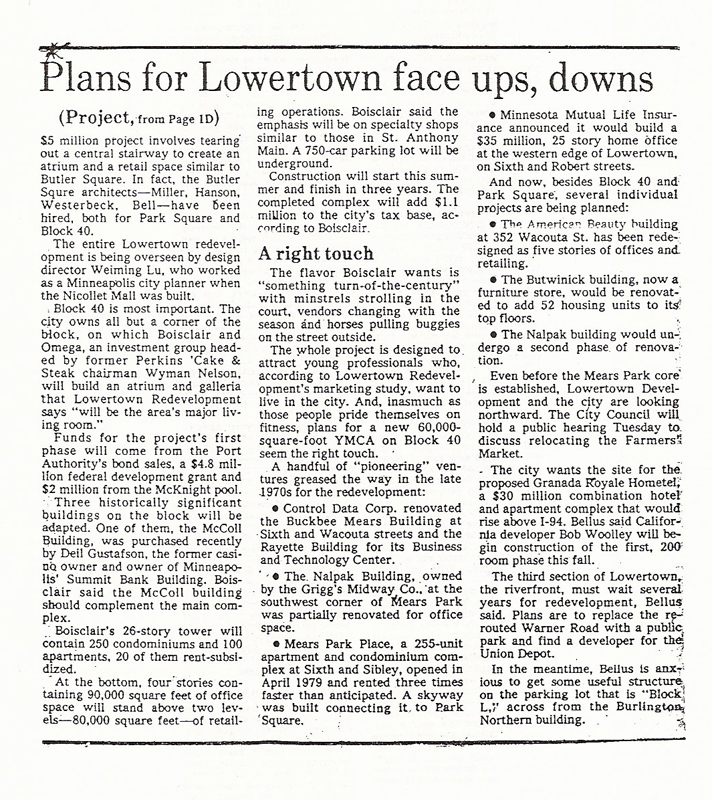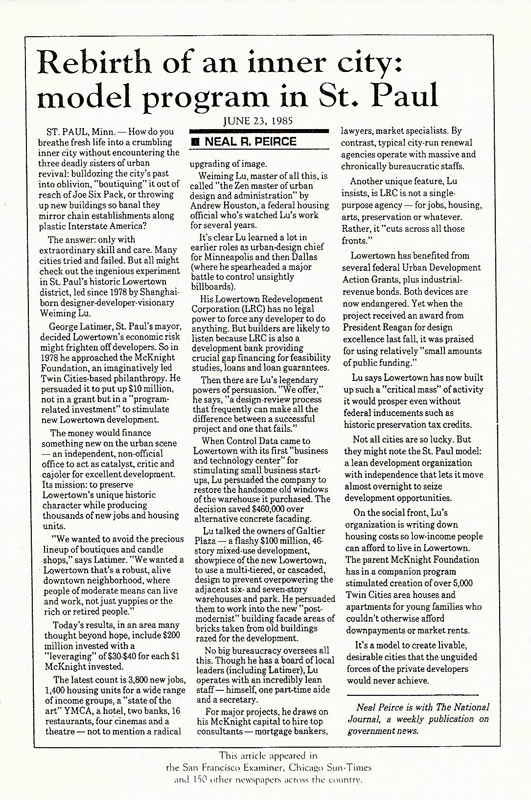
Lowertown Redevelopment
Lowertown has been on a long road to recovery, but the neighborhood is now developing at an increasingly fast pace.
"After the Depression, Lowertown declined. The first project to focus attention on the revitalization potential of Lowertown was the renovation of the Merchant’s National Bank Building (now McColl Building) in the late 1960s. This was soon followed by the conversion of the Noyes Brothers and Cutler Building into a complex of offices, shops, and restaurants now known as Park Square Court. The City’s Housing and Redevelopment Authority (HRA) became involved in 1973 when Mears Park was redesigned by William Sanders and renamed after Norman B. Mears, a Saint Paul businessman who spurred Lowertown redevelopment. The HRA and City of St. Paul have since encouraged renovation and development in Lowertown.
In April, 1978 the Lowertown Redevelopment Corporation (LRC) was organized with the goal of creating “a place for people, a highly livable urban village in the midst of the city, which will bring new jobs, housing, commercial development, and year round activities to Lowertown and infuse the city with renewed vitality.” Enabled by an unprecedented $10 million grant by the McKnight Foundation, the LRC assumed the role and responsibility of driving the revitalization of Lowertown. [At the helm of the LRC was Weiming Lu who was once called the Zen master of urban design and administration by a federal housing official who worked with him for several years.] Checkout his book ‘The Tao of Urban Rejuvenation’.
Throughout the 1970s and 1980s, artists moved to Lowertown. Attracted by low rents, raw space and relative quiet, artists from around the region saw opportunity in Lowertown. Slowly and quietly, a new, risk-tolerant population began to bring life to the buildings and the streets of Lowertown. Initiated by the LRC and supported fully by the City of St. Paul, Lowertown was listed on the National Register of Historic Places in 1983. This gave the area protection under the National Historic Preservation Act of 1966. The next year, the City of St. Paul designated the Lowertown Historic District as a Heritage Preservation Site.
Aided by these designations and the associated tax credits, Artspace, the LRC, the City and others partnered to renovate three buildings dedicated to the arts. The Lowertown Artists Lofts Cooperative, the Tilsner and the Northern Warehouse were renovated and became the anchors for the arts community. Throughout the years, there has been a steady commitment to incrementally reinvest in the assets of Lowertown. Instead of demolishing and building new, Lowertown remained committed to a slow, deliberate and steady approach to redevelopment. This approach allowed Lowertown to remain a relatively quiet neighborhood on the edge of downtown. Such an approach was particularly supportive of the artist community, as it respected the financial and environmental needs of working artists.
In 1982, the St. Paul Farmers’ Market moved to Lowertown. An institution since the late 1800s, the Farmers’ Market was an anomaly of sorts for Lowertown - it was a destination in the middle of a relatively quiet neighborhood. The market now draws 20,000 people each weekend in the summer. [In 2006 the LRC transformed into the Lowertown Future Fund to continue supporting Lowertown redevelopment.]
Recently, a few new buildings have been added to the mix, attracting new residents paying market rate for condominiums. In addition, restaurants and other regional attractions [such as the restored Union Depot] have opened in Lowertown, continuing Lowertown’s evolution." (Greater Lowertown Master Plan, 2011)
Minnesota Historical Society: Lowertown Redevelopment Corporation (LRC) Archive (1961-2007)
Minnesota Historical Society: Weiming Lu Biography
Lowertown Yards: Urban Green Infrastructure A Vision for Reclaiming River Land from Industry and Parking: Colleen Bell
Lowertown Yards: Public Space from Renewed Infrastructure in Saint Paul: Colleen O'Dell




